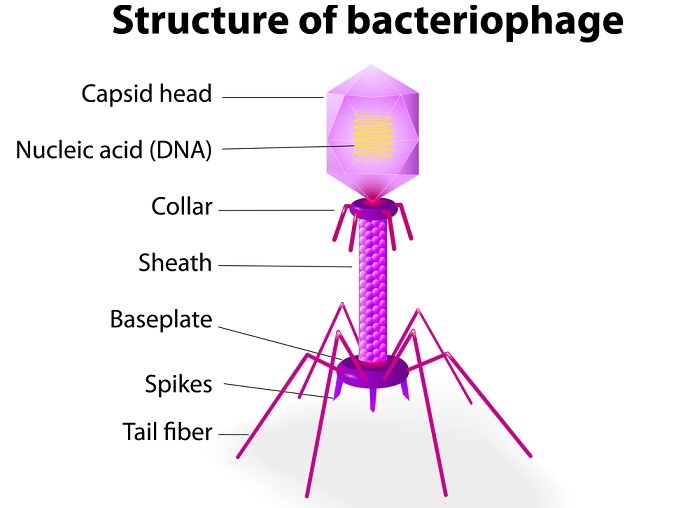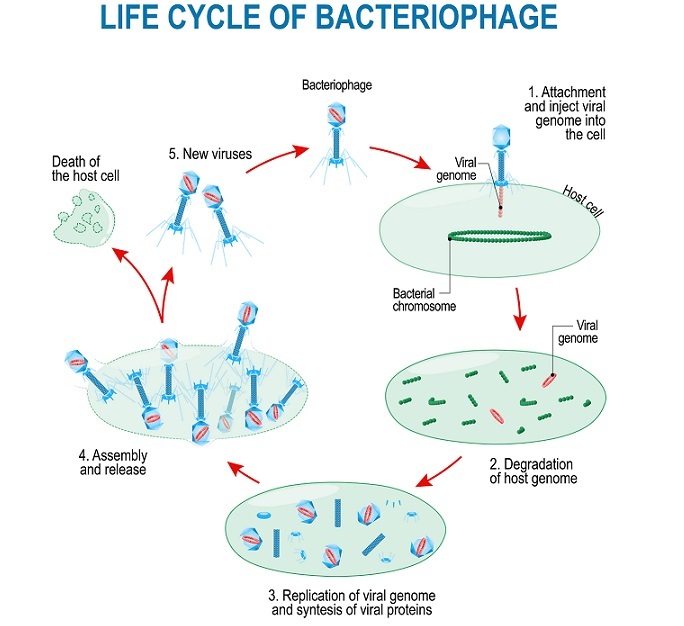
 Data Structure
Data Structure Networking
Networking RDBMS
RDBMS Operating System
Operating System Java
Java MS Excel
MS Excel iOS
iOS HTML
HTML CSS
CSS Android
Android Python
Python C Programming
C Programming C++
C++ C#
C# MongoDB
MongoDB MySQL
MySQL Javascript
Javascript PHP
PHP
- Selected Reading
- UPSC IAS Exams Notes
- Developer's Best Practices
- Questions and Answers
- Effective Resume Writing
- HR Interview Questions
- Computer Glossary
- Who is Who
What Is a Bacteriophage and Describe Its Life Cycle?
Introduction
Bacteriophages as the name suggests are a class of viruses that feed on bacteria and archaea. In other words, they can be called the viruses of bacteria. They do not have any location but are found everywhere that is they are ubiquitous organisms. Since their discovery, they have been found to be of great importance as tools in molecular biology and recombinant DNA technology.
Nowadays they are used as vectors to carry segments of DNA of interest to the host genome. Scientists are studying more about their evolution and their role in natural ecosystems. In this section, we will be briefing about the history, structure, life cycle, and significance of bacteriophages.

History
It all started when Hanbury Hankins in 1896 found out that the water of rivers Ganga and Yamuna have certain antibacterial functions and are very minute, but he did not know the reason. Later, bacteriophages were first discovered by Frederick W. Twort and Felix d'Herelle and it was d'Herelle who coined the term bacteriophage in 1917.
Structure of Bacteriophages
Depending on the type or group of bacteria they infect, bacteriophages are of different types. But all types have some common features which are as follows-
The basic structure of phages includes a protein capsid which encloses the nuclear material.
They can be found in three different structures- icosahedral head with a tail, filamentous form, or icosahedral head without a tail.
Nuclear material that is enclosed within the capsid can be RNA or DNA which can be single-stranded or double-stranded.
Just like other viruses they are also non-living outside the body of the host and to carry out their metabolic activities they need machinery.
Basic components of bacteriophage are the head, collar, and helical tail.
Head- It encloses double-stranded DNA or single-stranded RNA and is made up of 2000capsomers.
Tail- It is made up of hollow tubes that are surrounded by annular rings and contractile sheath. The upper part of the tail contains a basal plate that contains tail fiber at each end.
Life Cycle of Bacteriophage
The life cycle of bacteriophage consists of three main processes that are the entry of the virus into bacteria, its replication, and its exit from the host cell. The process of entry of bacteriophages into the host cell is similar wherein phage enters the bacterial cells in order to replicate. But after that depending on the mechanism of DNA replication life cycle of bacteriophage can be divided into two types, they are-
Lytic Cycle
Lysogenic Cycle
Lytic Cycle
In this lifecycle of bacteriophage in which the viral DNA replicates independently of the host DNA as it remains free-floating.

The virulent phages cause the destruction of the cell membrane when the viral particles are released. In such viral phages, a lytic cycle can be observed.
This cycle acts as a viral infection as it causes the destruction of the host bacterial cell.
Lytic cycle of bacteriophages takes place in the following steps-
Attachment and penetration
In this step ligands that are present on the surface of the viral particles bind to the receptors present on the surface of the bacterial host cells.
A high degree of specificity can be observed between ligands and receptors, even then most bacteriophages use the same receptors.
Once the bacteriophage successfully attaches to the host cell, it injects the nuclear material into the cytoplasm of the bacterial cell.
Transcription of RNA to DNA
In the cytoplasm the viral genome exploits the bacteria's cellular mechanism to multiply themselves.
If the genetic material of the virus is DNA, it transcribes into mRNA which then codes for proteins that cause the destruction of host DNA.
If the genetic material of virus is RNA, an enzyme called as reverse transcriptase converts RNA into double-stranded DNA which then transcribes to mRNA. mRNA codes for proteins that cause the destruction of the host cell.
After the destruction, the viral DNA takes over the host cell and produces proteins required for the assembly of new viruses.
Assembly and Lysis
After the formation of viral particles, genetic material is assembled into the viral capsid. These newly formed phages produce an enzyme called lysin which causes the lysis of the host cell membrane and new bacteriophages are released.
Lysogenic cycle
In this mechanism host cell is not destroyed by the phage particle that is why it is also called as the temperate phage.
Instead of killing the host cell, bacteriophage incorporates the viral genome into host genome, and it continues to live inside the host cell after the replication process.
The incorporation of the viral genome into the host genome leads to the formation of prophage which is transferred to the daughter cell during cell division.
Applications of Bacteriophages
A few of the applications include ?
Since bacteriophages destroy only bacteria and are safe for humans, they can be used in the treatment of some diseases caused by bacteria.
They are used to remove certain bacterial contaminants from the surfaces of food and food spoilage can be avoided.
Bacteriophages have been successfully used to prevent and treat bacterial infection in plants and help in disease control.
Phage therapy is considered the most recent alternative to antibiotics and is found effective against some bacterial species like Proteus, Enterococcus, Staphylococcus, etc.
Conclusion
Bacteriophages are known to humans for more than a century and they are also known as bacteria eaters since they cause the destruction of the bacterial cells. These bacteriophages replicate themselves by using host cellular machinery and their life cycle includes two main mechanisms or pathways namely lytic and lysogenic cycle.
Although the mechanism of their replication and transcription is fully understood still their use as a replacement to antibiotics is in naïve condition and more work has been done to use them against bacteria as they are more efficient against antibiotic-resistant bacteria.

